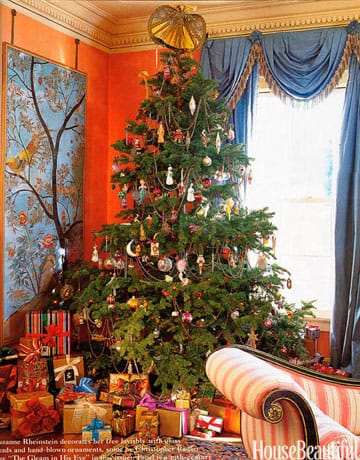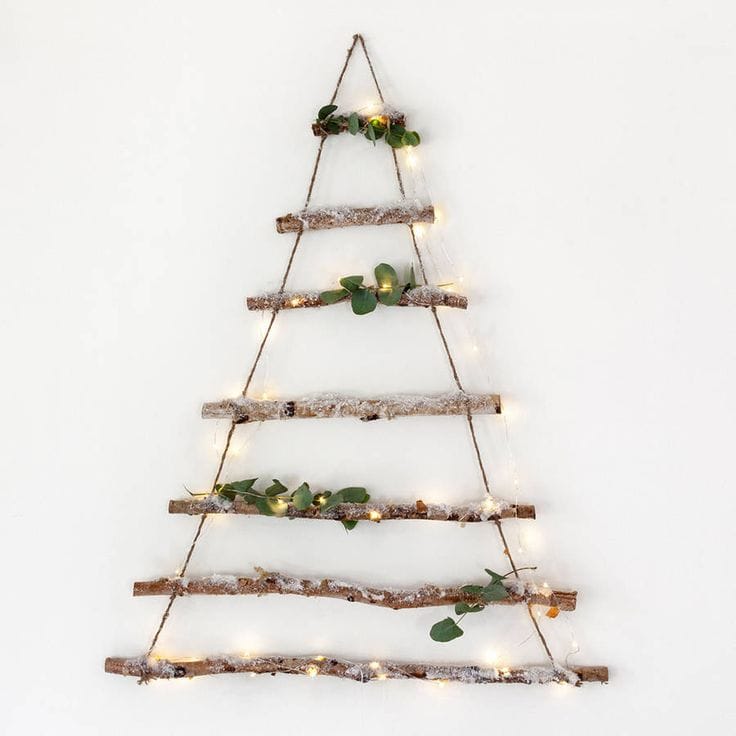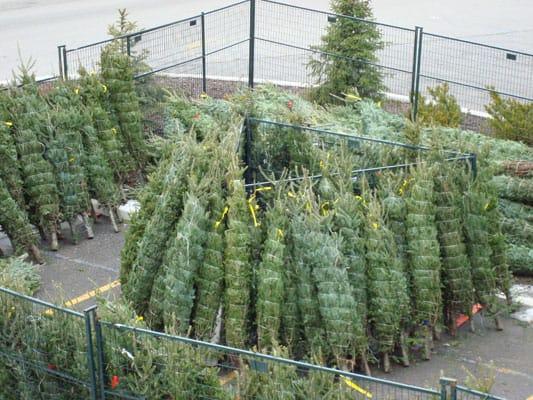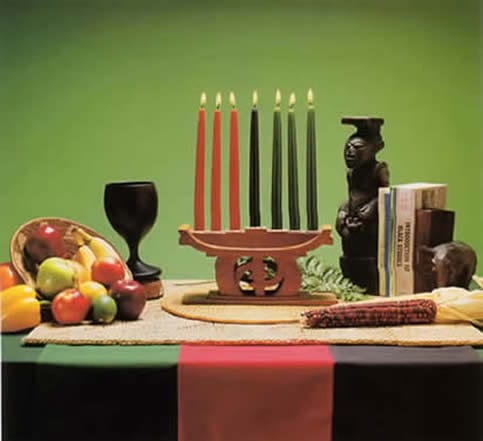“O Christmas Tree! O Christmas Tree!
Thy leaves are so unchanging!
O Christmas Tree! O Christmas Tree!
Such pleasure do you bring me…
Each shining light each silver bell
No other light spreads cheer so well…
A symbol of good will and love
You'll ever be unchanging… “
Thy leaves are so unchanging!
O Christmas Tree! O Christmas Tree!
Such pleasure do you bring me…
Each shining light each silver bell
No other light spreads cheer so well…
A symbol of good will and love
You'll ever be unchanging… “
Photo credit: House Beautiful
Until you die in the next few weeks...
Do you love to decorate your beautiful Christmas Tree every year?
Does it make you feel warm inside to see it all lit up and colorfully decorated?
Do you ever pause to think about why we follow this tradition?
Does it make you feel warm inside to see it all lit up and colorfully decorated?
Do you ever pause to think about why we follow this tradition?
Evergreen trees have traditionally been used to celebrate winter festivals (pagan and Christian) for thousands of years. Plants and trees that remain green all year had a special meaning for people in the winter. Ancient people hung evergreen boughs over their doors and windows. In many countries, it was believed that evergreens would keep away ghosts, evil spirits, and illness. The Romans used these trees to decorate their temples at the festival of Saturnalia. Christians use them as a sign of everlasting life with God as the leaves remain evergreen.
Early Christmas Trees, across many parts of northern Europe, were often symbolized by the use plants or a branch of the plant, that were put into pots and brought inside so they would hopefully flower at Christmas time. People who couldn't afford a real tree or plant, made pyramids of fallen wood and they were decorated to look like a tree with candied apples, gingerbread, and candles. Sometimes they were carried around from house to house, rather than being displayed in a home.
(http://www.whychristmas.com/customs/trees.shtml)
Early Christmas Trees, across many parts of northern Europe, were often symbolized by the use plants or a branch of the plant, that were put into pots and brought inside so they would hopefully flower at Christmas time. People who couldn't afford a real tree or plant, made pyramids of fallen wood and they were decorated to look like a tree with candied apples, gingerbread, and candles. Sometimes they were carried around from house to house, rather than being displayed in a home.
(http://www.whychristmas.com/customs/trees.shtml)
There are many stories told in differing cultures about where the Christmas tree tradition began. One story suggests that first person to bring a Christmas Tree into a house, may have been the 16th century German preacher Martin Luther. According to this legend, one night before Christmas, he was walking through the forest and looked up to see the stars shining through the tree branches. It was so beautiful, that he went home and told his children that it reminded him of Jesus, who left the stars of heaven to come to earth at Christmas. To recapture the scene for his family, he erected a tree in the main room and wrapped lighted candles around the branches.
And so, the modern tradition began, of bringing an evergreen tree into your house each year. Christmas trees have been sold commercially in the United States since about 1850 (http://www.history.com/topics/christmas/history-of-christmas-trees).
And so, the modern tradition began, of bringing an evergreen tree into your house each year. Christmas trees have been sold commercially in the United States since about 1850 (http://www.history.com/topics/christmas/history-of-christmas-trees).
Now, all over the world, cultures celebrate Christmas with trees. 34 to 36 million Christmas trees are produced each year in America, and 50 to 60 million are produced in Europe. The most popular trees used for Christmas are Scotch Pine, Douglas Fir, Fraser Fir, Balsam Fir, and White Pine.
Different cultures decorate them differently with lights, stars, snowflakes, apples, gingerbread, gold, candles, colorful ornaments, pieces of cotton that represent falling snow, or other symbols like angels, photos, stockings, etc. For most of the Japanese who celebrate Christmas, it’s purely a secular holiday devoted to the love of their children. Christmas trees are decorated with small toys, dolls, paper ornaments, gold paper fans and lanterns, and wind chimes. Of the small percentage of Chinese who do celebrate Christmas, Christmas trees are called “trees of light," and most erect artificial trees decorated with sparkles and paper chains, flowers, and lanterns. In the Phillipines, where pine trees are hard to find and afford, a star shaped lantern ornament, called a parol, is made out of bamboo and covered in brightly colored rice paper. They are placed in each window, representing the Star of Bethlehem.
Star of Bethlahem in windows at Cafe Chloe
As the years passed in my adult life, I haven’t been able to follow through with this tradition of putting a freshly cut tree inside of my house for only a few weeks. It never felt right to me and now I finally know why. I’ve been reading a book called The Hidden Life of Trees: What They Feel, How They Communicate—Discoveries from A Secret World by Peter Wohlleben.
Did you know that trees are similar to animals?
“There is a burst of careful scientific research occurring worldwide that is uncovering all manner of ways that trees communicate with each other above and below ground.” They communicate with each other through electrical vibrations, sounds, at a frequency that we cannot hear.
When they are thirsty, trees will scream out for help and if they have a companion nearby, another tree can slowly extend its roots to give nourishment to a friend. Trees have families too. “It appears that nutrient exchange and helping neighbors in times of need is the rule, and this leads to the conclusion that forests are superorganisms with interconnections much like ant colonies.”
They also communicate with scent to protect their species. Information travels via the roots by means of electrical impulses at the speed of a third of an inch per second. In comparison with our bodies, it is extremely slow. However, there are species in the animal kingdom, such as jellyfish and worms, whose nervous systems conduct impulses at similar speed.
Ancient happy forests also communicate contentment through sound waves and scents, which is how we can feel so peaceful when we take a long walk in the forest.
“There is a burst of careful scientific research occurring worldwide that is uncovering all manner of ways that trees communicate with each other above and below ground.” They communicate with each other through electrical vibrations, sounds, at a frequency that we cannot hear.
When they are thirsty, trees will scream out for help and if they have a companion nearby, another tree can slowly extend its roots to give nourishment to a friend. Trees have families too. “It appears that nutrient exchange and helping neighbors in times of need is the rule, and this leads to the conclusion that forests are superorganisms with interconnections much like ant colonies.”
They also communicate with scent to protect their species. Information travels via the roots by means of electrical impulses at the speed of a third of an inch per second. In comparison with our bodies, it is extremely slow. However, there are species in the animal kingdom, such as jellyfish and worms, whose nervous systems conduct impulses at similar speed.
Ancient happy forests also communicate contentment through sound waves and scents, which is how we can feel so peaceful when we take a long walk in the forest.
If we could hear trees,
would that change how we treat them?
In Christmas Tree farms, trees are murdered after only being alive for 7 to 10 years.
Why sacrifice a tree’s life for only 2-3 weeks of decoration?
This is a similar ritual as the concept of child sacrifice that was practiced by many ancient cultures including the Incas. Everyone just went along with it in the name of tradition.
And what about the trees that don’t get sold?
They have already been separated from their life source, their roots that serve as brains. These trees are wasted. They could be giving oxygen back to the environment, but instead, they will most likely go into a landfill.
Why sacrifice a tree’s life for only 2-3 weeks of decoration?
This is a similar ritual as the concept of child sacrifice that was practiced by many ancient cultures including the Incas. Everyone just went along with it in the name of tradition.
And what about the trees that don’t get sold?
They have already been separated from their life source, their roots that serve as brains. These trees are wasted. They could be giving oxygen back to the environment, but instead, they will most likely go into a landfill.
In this clip of Friends, I relate to Phoebe’s distaste for Christmas Tree lots and the process of killing trees.
However, unlike this clip, trees don’t have any desire to be cut down and sacrificed in the name of one of our holidays.
However, unlike this clip, trees don’t have any desire to be cut down and sacrificed in the name of one of our holidays.
In yoga philosophy, the very first Yama (one of the 8 limbs of Yoga Philosophy about Universal Morality) is Ahimsa, meaning kindness and doing no harm to other living beings. Some people translate this to mean no hunting or eating meat, but what about the plants? They are living beings too. Yes, we must eat some type of living being to survive, either plants or meat or both, but we don’t need to waste our resources and indulge in excess.
What do you do with your tree after Christmas?
If you use your tree for warmth in a fire, then the tree did serve a purpose for shelter. Be careful to only use these branches in an outdoor fire pit as creosote build-up is a hazard in indoor fireplaces.
I hope you remember Ahimsa throughout your holiday season and year. Take a walk in a forest. Be still and listen. Maybe you can even pick up on a conversation amongst these ancient wise ones, our givers of life, oxygen.
What do you do with your tree after Christmas?
If you use your tree for warmth in a fire, then the tree did serve a purpose for shelter. Be careful to only use these branches in an outdoor fire pit as creosote build-up is a hazard in indoor fireplaces.
I hope you remember Ahimsa throughout your holiday season and year. Take a walk in a forest. Be still and listen. Maybe you can even pick up on a conversation amongst these ancient wise ones, our givers of life, oxygen.
Ahimsa- Yoga Philosophy of kindness to all living beings.
Trees actually feel hurt when part of their branches are cut off!
Notice the tears!
Notice the tears!
Are you also an omnist, a person who does not claim any one religion but finds truth in them all?
Did you know that there is a common denominator around the world's major winter’s holidays?
All of these celebrations include light which translates to unity and love.
All of these celebrations include light which translates to unity and love.
Many tribal groups celebrate the winter solstice as the invitation to let light and longer days back into the Northern Hemisphere.
The Yuletide festivities include partially burning a log on the winter solstice and keeping that log in your house all year to bring magical powers.
The Yuletide festivities include partially burning a log on the winter solstice and keeping that log in your house all year to bring magical powers.
The three wise men followed a bright star to lead them to baby Jesus.
Jews around the world celebrate Chanukah, a wintertime “festival of lights,” with a nightly menorah lighting and special prayers.
Diwali is the Hindu festival of lights celebrated every year. One of the major festivals, it spiritually signifies the victory of light over darkness, good over evil, knowledge over ignorance, and hope over despair.
Further, Kwanza also celebrates life and the 7 principles through lighting 7 candlesticks.
Diwali is the Hindu festival of lights celebrated every year. One of the major festivals, it spiritually signifies the victory of light over darkness, good over evil, knowledge over ignorance, and hope over despair.
Further, Kwanza also celebrates life and the 7 principles through lighting 7 candlesticks.
In Scandinavia, Saint Lucy’s day is celebrated with wreaths of candles worn as headpieces. Saint Lucy brought food to the martyr Christians who were hiding in the catacombs. The bright headpiece illuminated the way of love.
In addition, the Lady of Guadelupe is a symbol of unification between many different religions in Mexico. She is honored during this time of year and depicted wearing a bright golden crown that creates a circle of light around her entire being.
In addition, the Lady of Guadelupe is a symbol of unification between many different religions in Mexico. She is honored during this time of year and depicted wearing a bright golden crown that creates a circle of light around her entire being.
Further, the crescent moon is a symbol for Ramadan as it determines the one month of fasting from New Moon to New Moon on the Islamic calendar. Fasts begin at dawn and last till dusk, and so the moon is shines as the light through darkness and represents the time available for eating and prayers.
Instead of buying and killing trees,
I recommend the following 2 suggestions for celebrating Light and Life this season:
1) Decorate a house plant with ornaments and lights. By using fallen branches or plant pieces, we do not have to kill entire beings.
2) Buy a live tree with its roots in a planter and plant it in your yard. Select a tree that's right for your climate, soil and light conditions. You still have the option to decorate with it lights and ornaments.
I recommend the following 2 suggestions for celebrating Light and Life this season:
1) Decorate a house plant with ornaments and lights. By using fallen branches or plant pieces, we do not have to kill entire beings.
2) Buy a live tree with its roots in a planter and plant it in your yard. Select a tree that's right for your climate, soil and light conditions. You still have the option to decorate with it lights and ornaments.
Celebrate trees with these Winter Trees, Foggy Park Leggings.
Although they shed their leaves in the winter, they are still very much alive and ready for a new year of growth. Are you?
Stay tuned for next week as we discuss our goals for growth as we bring in the new year.
Although they shed their leaves in the winter, they are still very much alive and ready for a new year of growth. Are you?
Stay tuned for next week as we discuss our goals for growth as we bring in the new year.


































